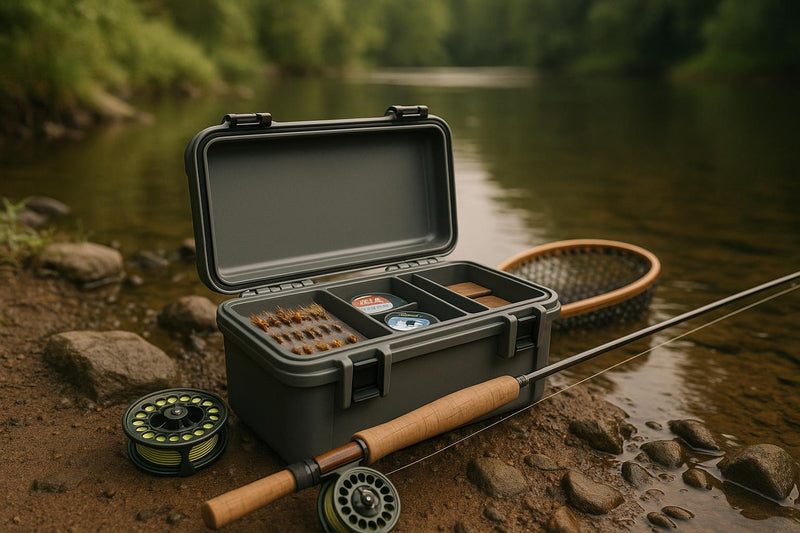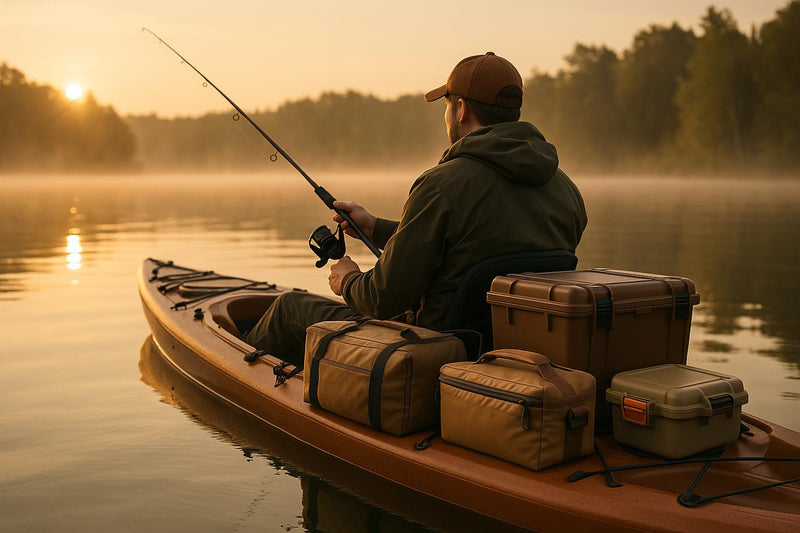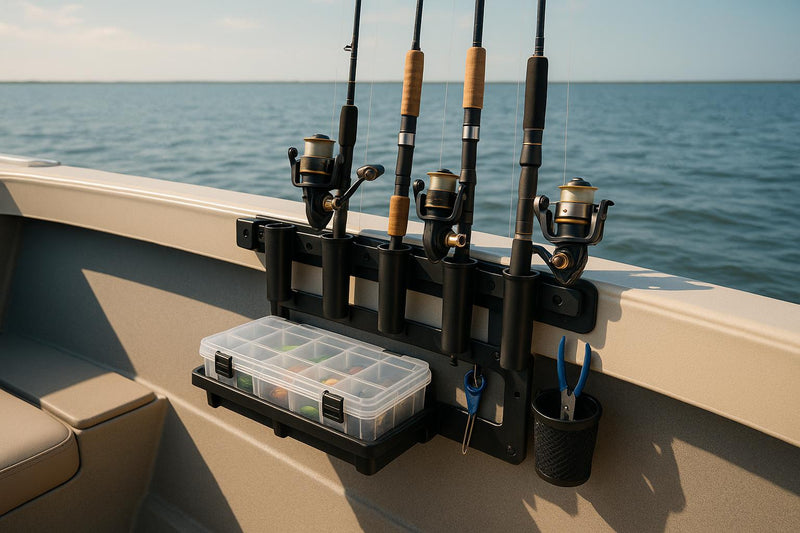Reinforced stitching makes fishing gear last longer. By using stronger threads and tighter patterns, it strengthens high-stress areas like pockets and seams, ensuring durability in tough conditions. This reduces wear and tear caused by saltwater, sun, and frequent use, saving you from costly replacements.
Key points:
- Durability: Reinforced stitching withstands heavy use, while standard stitching wears out faster.
- Cost-effectiveness: Higher upfront cost, but fewer repairs and replacements over time.
- Comfort: Ergonomic seams improve fit and reduce chafing during long trips.
- Maintenance: Easier to clean and resistant to fraying.
If you're serious about fishing, investing in gear with reinforced stitching, like Reel Comfort's $59.99 fishing shorts, ensures reliability and long-term value.
1. Fishing Shorts with Reinforced Stitching
When it comes to fishing shorts, reinforced stitching takes durability to the next level. By adding extra layers at high-stress areas and using stronger thread, this technique ensures the shorts can handle the demands of rigorous fishing activities. This method isn't just about better sewing - it's about creating gear that stands up to the elements and the wear-and-tear of long days on the water.
Durability
The durability of reinforced stitching becomes clear when you're out fishing. Areas like pocket corners, waistbands, and inseams are designed to hold up against repeated casting, sitting on rocky shores, or hours spent on a boat. For example, Reel Comfort's fishing shorts combine reinforced stitching with rip-stop fabric, protecting against tears, saltwater exposure, and UV damage. Key features like removable thigh pad attachments and reinforced pockets ensure these shorts are tough enough for any angling adventure.
Cost-Effectiveness
While shorts with reinforced stitching may cost a bit more upfront, they save money in the long run. Their extended lifespan means fewer repairs and replacements compared to shorts with standard stitching. Features like four-way stretch panels also help distribute stress more evenly, reducing wear in specific areas. Over time, this durability lowers the cost per wear, making them a smart investment for frequent anglers.
Comfort and Performance
Reinforced stitching doesn’t just boost durability - it also enhances comfort. Strategically placed seams reduce pressure points, and when paired with an ergonomic, anti-chafe design, they keep you comfortable even during long fishing trips. The quick-dry, water-resistant fabric ensures the shorts maintain their shape and performance in wet conditions. Whether you're casting or maneuvering on a boat, these shorts move naturally with your body, ensuring unrestricted mobility.
Maintenance and Wear
One of the practical benefits of reinforced stitching is easier maintenance. The sturdy seams resist fraying and loose threads, meaning the shorts can handle more frequent and intense cleaning - perfect after a day in saltwater or dealing with muddy conditions. Additionally, the reinforced seams help preserve the fabric's water-resistant qualities by preventing gaps that could compromise its integrity.
For anglers who need gear that combines toughness, comfort, and easy care, Reel Comfort's fishing shorts are a standout choice. They’re built to last, perform, and keep up with the demands of any fishing trip.
2. Fishing Shorts with Standard Stitching
After examining the advantages of reinforced stitching, it's clear that standard stitching falls short when subjected to the rigors of fishing. Standard stitching relies on basic sewing techniques without any additional reinforcement. While these shorts might look just as sturdy at first glance, their weaknesses become evident when put to the test in demanding fishing environments.
Durability
Fishing shorts with standard stitching simply don’t provide the same level of durability as those with reinforced construction. High-stress areas are particularly vulnerable, as repeated wear and tear can cause seams to fray, loosen, or even tear apart - even if the fabric itself remains intact. Although many manufacturers use tough materials like ripstop nylon or polyester blends to resist water, salt, and fish scales, the stitching often becomes the weak point in harsh conditions. This difference underscores the added resilience that reinforced stitching offers.
Comfort and Performance
When seams start to wear out, it’s not just about appearance - comfort and functionality take a hit too. Loose or damaged stitching can affect the fit and stability of the shorts, making them less comfortable and reliable over time. In contrast, reinforced stitching enhances durability, ensuring a better fit and consistent performance throughout their lifespan.
Maintenance and Wear
Given the durability concerns, proper care is even more essential for fishing shorts with standard stitching. Following the manufacturer’s care instructions can help prolong their lifespan. Avoid using bleach or fabric softeners, and hang dry the shorts instead of using a dryer to minimize stress on the seams. Regularly inspecting the stitching for signs of wear can also prevent small issues from escalating into bigger problems.
For anglers who prioritize durability and long-term performance, Reel Comfort provides premium options. Explore their selection of versatile Fishing Shorts or their specialized Men’s Fishing Shorts to find gear that stands up to the challenge.
sbb-itb-cb0a783
Pros and Cons Analysis
When deciding between reinforced stitching and standard stitching for fishing shorts, it's essential to consider the strengths and weaknesses of each option. Reinforced stitching is built for durability and consistent performance, while standard stitching offers a more budget-friendly choice upfront. Here's a detailed comparison of the two:
| Factor | Reinforced Stitching | Standard Stitching |
|---|---|---|
| Upfront Investment | Higher initial cost due to superior construction | Lower initial price, but durability may be compromised |
| Durability | Built to last; handles heavy and frequent use | Less sturdy; shows wear more quickly |
| Maintenance | Minimal upkeep needed thanks to stronger seams | Requires regular checks and repairs |
| Comfort Consistency | Retains fit and performance over time | Seams may loosen, affecting comfort |
| Long-term Value | Cost-effective in the long run due to extended lifespan | Lower upfront cost, but frequent replacements can add up |
Let’s dive deeper into the advantages and limitations of both stitching methods.
Reinforced Stitching Advantages
Reinforced stitching stands out for its long-term reliability. While it comes with a higher price tag initially, the enhanced durability ensures fewer issues over time. These shorts are designed to withstand heavy usage, making them ideal for anglers who frequently face tough conditions. With reinforced seams, you can count on your gear to perform without fail, allowing you to focus on the thrill of fishing. Check out Reel Comfort's Fishing Shorts for examples of gear that embodies these benefits.
Reinforced Stitching Drawbacks
The main downside of reinforced stitching is the upfront cost, which might be a hurdle for those on a tighter budget. Additionally, some styles may feel slightly stiff when new, though this typically softens with regular wear.
Standard Stitching Benefits
Standard stitching is a cost-effective choice, particularly for beginners or anglers who fish occasionally. Its lower price makes it an accessible option for building a fishing wardrobe without a significant financial commitment.
Standard Stitching Limitations
However, the trade-off is durability. Shorts with standard stitching are more prone to wear and tear, especially with frequent use. They may require more maintenance to keep the seams intact and are likely to need replacement sooner, which can lead to higher cumulative costs over time.
Making the Right Choice
For anglers who fish often or in challenging conditions, reinforced stitching is the smarter investment, offering reliability and better long-term value. On the other hand, standard stitching might work for casual anglers or those who fish less frequently, though the need for replacements could outweigh the initial savings.
If durability and comfort are priorities, Reel Comfort's collection of Mens Fishing Shorts highlights the benefits of reinforced stitching. Explore their Fishing Shorts to see how superior construction can extend the lifespan of your gear.
Conclusion
When you weigh durability, cost over time, and performance, the choice becomes clear: reinforced stitching transforms fishing shorts into a dependable, long-term investment. While standard stitching might seem like the cheaper option upfront, the expenses of frequent repairs and replacements can quickly make it the pricier route in the long run.
Reinforced stitching strengthens critical stress points, allowing fishing shorts to endure the demands of rigorous use. This added durability significantly reduces the risk of wear and tear, which is often the culprit behind premature replacements. As one satisfied angler put it, "I like the quality, they last forever and ever". Manufacturers who focus on reinforcing these key areas ensure their products stand up to the challenges of serious fishing adventures.
With an impressive customer rating averaging 4.74/5, these shorts have proven their ability to deliver both comfort and long-lasting performance.
Ultimately, it boils down to this: invest once in quality or keep paying for replacements. Savvy anglers consistently opt for durability, comfort, and long-term value. Make the smart choice - upgrade your fishing gear with Reel Comfort's Fishing Shorts and Men's Fishing Shorts for reliable performance that lasts.
FAQs
How does reinforced stitching improve the durability of fishing shorts?
Reinforced stitching plays a big role in making fishing shorts tougher and more reliable. By strengthening the seams, it reduces the chances of them splitting, even when put through the strain of constant use, exposure to water, and rough outdoor environments.
This extra durability means your fishing shorts can handle more wear and tear without giving out. In the long run, it not only saves you money by extending the life of your gear but also keeps you comfortable, especially during those long days out on the water.
How does reinforced stitching make fishing gear more durable and cost-effective?
Reinforced stitching adds extra strength to fishing gear, making it tougher against wear and tear, particularly in areas that endure the most stress. This boost in durability helps your gear hold up longer, cutting down on the need for constant repairs or replacements.
Choosing well-made equipment, such as padded fishing shorts, not only ensures dependable performance on every trip but also saves anglers money in the long run.
How can I take care of fishing shorts with reinforced stitching to make them last longer?
To keep your fishing shorts with reinforced stitching in top condition, rinse them with fresh water after every use to wash away salt, dirt, and debris. Skip the harsh detergents - they can weaken the stitching over time. Instead, stick to gentle cleaning methods. Air drying is the way to go, as it helps avoid unnecessary strain on the fabric and seams.
Take a moment every so often to check the reinforced areas for any signs of wear or fraying. Catching small issues early and repairing them can save your shorts from bigger problems down the line. When you're not wearing them, store your shorts in a cool, dry spot to preserve their durability and make them last longer.




